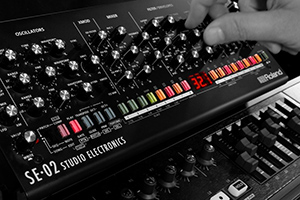The Roland SH-09, released in 1980, is a monophonic analogue synthesizer that has long been overshadowed by its more celebrated siblings like the SH-101, MC-202, and TB-303. However, this humble instrument deserves far more recognition than it typically receives. While it lacks the sequencing capabilities of its stable-mates (which were released a couple of years later), the SH-09 stands as an ideal entry point into analogue synthesis, offering operational simplicity without sacrificing sonic character or flexibility.
Architecture & Sound Engine
At its core, the SH-09 features a single voltage-controlled oscillator (VCO) capable of producing four basic waveforms: sawtooth, square, pulse, and noise. The oscillator's octave range is switchable between 32 and 2 feet, providing substantial tonal range. A particularly valuable feature is the pulse width modulation capability, where the mark/space ratio of the square/pulse waveform can be set statically or modulated by the LFO—a classic thickening technique for single-oscillator synthesizers.
Complementing the main oscillator is a sub-oscillator that significantly enhances the instrument's bass capabilities. This sub-oscillator can deliver either a square or pulse waveform set one octave below the main oscillator's frequency, or a pulse waveform only at two octaves below. This feature has made the SH-09 responsible for many deep, squelchy bass lines that have undoubtedly tested the limits of countless bass speaker cones over the years.
Filter Character
The SH-09's 24 dB/octave resonant low-pass filter embodies the distinctive Roland analogue filter sound. While relatively tame compared to Moog or ARP filters, it exhibits a particular musicality that sets it apart. The filter excels in the territories where the TB-303, SH-101, and MC-202 thrive—producing blooping, squeaking sounds—but many users find the SH-09 delivers an even warmer, more squelchy character. The filter happily runs into self-oscillation and offers modulation options from both the LFO and envelope generator.
Envelope Generator
The full ADSR envelope generator serves double duty, controlling both amplitude and filter modulation. An unusual and valuable feature allows the envelope to modulate pulse width as well, creating delightfully twangy sounds. The VCA section offers exceptional flexibility: it can switch between gate or envelope control, or be held continuously open. This allows for sophisticated programming where the envelope controls only the filter while the amp responds directly to keyboard gate signals—particularly useful for bass line programming that requires filter movement without amplitude decay.
Modulation & Performance
The LFO provides square or sine waveforms for modulation purposes, with a helpful speed indicator LED. A standout feature is the LFO delay control, which gradually introduces modulation over time, partially compensating for the lack of a modulation wheel. The LFO can modulate both pitch (vibrato) and pulse width.
Performance controls are admittedly limited. A single left/right bender lever to the left of the keyboard can control pitch and/or filter cutoff via two sliders. While functional, real-time performance capabilities are somewhat constrained by modern standards, though MIDI-to-CV conversion can dramatically expand control options with aftertouch and modulation wheel functionality.
Additional Features
The mixer section provides level control for the oscillator, external input, and sub-oscillator. The external input is particularly noteworthy, allowing external audio to be processed through the SH-09's filter—useful for avant-garde vocal treatments or creative sound design. There's also a sample-and-hold function that excels at voltage-controlled filtering for acid-style sounds.
Sonic Character
The SH-09's sounds might not be described as "searing" or "fat," but they absolutely nail "cheesey" and "bleepy" territory. It's an excellent bass provider, though without the grit and thunder of Moogs or Oberheims. All those blippy-bleepy sequencing sounds are readily available, and the filter resonance ventures into territories many synthesizers refuse to explore. Delicate lead sounds are a particular strength, with oboes, flutes, and clarinet timbres in abundance. The machine's simplicity keeps results clean and uncluttered, helping sounds sit perfectly in a mix without overwhelming other instruments.
Legacy & Users
Despite often being regarded as a poor relation to more famous Roland classics, the SH-09 has found its way into the studios and live rigs of numerous notable artists including Orbital, Vince Clarke, BT, Conemelt, Josh Wink, Banco De Gaia, Mr. Oizo, Ladytron, Jimmy Edgar, Dave Holmes, Freddy Fresh, OMD, and 808 State.
The 32-note, two-and-a-half-octave keyboard was somewhat limiting in 1980, but with modern MIDI/CV control, this constraint largely disappears. The instrument's age means potential buyers should be aware of common issues including sticky keys, noisy potentiometers, and signal noise.
The SH-09 is a reliable workhorse that deserves serious consideration alongside its more famous siblings. It's an approachable, tactile instrument with no LCD screens in sight—just hands-on control and distinctive Roland analogue sound.
Technical Specifications
Type: Monophonic Analogue Synthesizer
Year of Release: 1980
Oscillator Section
- VCO: 1 voltage-controlled oscillator
- Waveforms: Sawtooth, Square, Pulse, Noise
- Octave Range: Switchable between 32' and 2'
- Pulse Width Modulation: Variable static setting or LFO modulation
- Sub-Oscillator: Square or pulse waveform (1 octave below main), or pulse only (2 octaves below main)
- Pitch Modulation: Via LFO (vibrato)
Filter Section
- Type: 24 dB/octave resonant low-pass filter
- Controls: Cutoff, Resonance
- Self-Oscillation: Yes
- Modulation Sources: LFO, Envelope Generator
- External Audio Input: Yes, for processing external signals through VCF
Modulation Section
- LFO Waveforms: Sine, Square, Sample-and-Hold
- LFO Destinations: Pitch, Pulse Width, Filter
- LFO Delay: Yes, with gradual introduction control
- LFO Speed Indicator: Red LED
Envelope Generator
- Type: ADSR (Attack, Decay, Sustain, Release)
- Destinations: VCA (amplitude), VCF (filter), Pulse Width
- VCA Modes: Envelope control, Gate control, or Hold (continuously open)
Mixer Section
- Level Controls: Main Oscillator, Sub-Oscillator, External Input
Keyboard & Performance Controls
- Keyboard: 32 keys (2.5 octaves)
- Pitch/Filter Bender: Single left/right lever with adjustable pitch and/or filter cutoff amount via sliders
Connectivity
- Control Voltage: CV/Gate inputs
- External Input: Yes, for audio processing
Additional Features
- Sample-and-Hold: Yes
- Arpeggiator/Sequencer: No
Physical Characteristics
- Polyphony: Monophonic
- Display: None (no LCD)
- Interface: Fully analogue with knobs and sliders
Common Age-Related Issues
- Sticky keys
- Noisy potentiometers
- Signal noise
Price tag (year 2025)
- USD700-1100 depending on the condition





